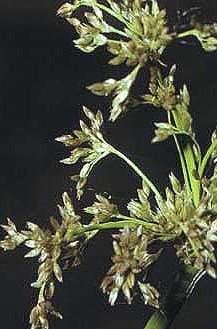Juncus roemerianus
| Juncus roemerianus | |
|---|---|
 |
|
| Scientific classification | |
| Kingdom: | Plantae |
| Clade: | Angiosperms |
| Clade: | Monocots |
| Clade: | Commelinids |
| Order: | Poales |
| Family: | Juncaceae |
| Genus: | Juncus |
| Species: | J. roemerianus |
| Binomial name | |
|
Juncus roemerianus Scheele |
|
Juncus roemerianus is a species of flowering plant in the rush family known by the common names black rush, needlerush, and black needlerush. It is native to North America, where its main distribution lies along the coastline of the southeastern United States, including the Gulf Coast. It occurs from New Jersey to Texas, with outlying populations in Connecticut, New York, Mexico, and certain Caribbean islands.
This rush is a perennial plant forming tufts of rough, rigid stems and leaves. It is gray-green in color. The plant may appear to be leafless at first glance, but what look like sharp-pointed stems are actually stiff leaves rolled tightly to form pointed cylinders. The true stems are tipped with inflorescences. It grows from a rhizome. This plant is variable in appearance. Its size and shape depend on environmental conditions in its salt marsh habitat. In areas with low soil salinity the plant can exceed two meters in height, whereas in high-salinity areas the rush is dwarfed, sometimes measuring under 30 centimeters (12 in.) tall. Both large and small plants generally occur in one marsh, with the large plants nearest the open water and the small plants occurring on higher ground in the salt flats and other areas of higher salinity. Plants of different sizes differ genetically, as well, with soil salinity being the selective force leading to the genetic variation. The dwarf plants have an adaptation to high soil salinity. Larger plants lack this adaptation, and do not survive when experimentally transplanted to high-salinity environments.
The plant reproduces sexually by seed and vegetatively by sprouting from its spreading rhizome. It expands its dense, sometimes monotypic stands by sending up new stems from the rhizome, and establishes new stands by broadcasting seeds. The species is gynodioecious, with some plants having bisexual flowers and some having only female reproductive parts. The seeds are very viable, germinating readily, but they require light for germination and may fail to sprout if covered in thick mud. Therefore, seedlings are most often seen in open, sandy stretches, and rarely in areas with dense vegetation or thick substrates. The plant grows new shoots and leaves year-round, and does not typically experience seasonal growth spurts. Dead leaves remain on the plant for a long time, leading to an accumulation of plant matter. The species may form much of the physical structure of the marsh.
...
Wikipedia

